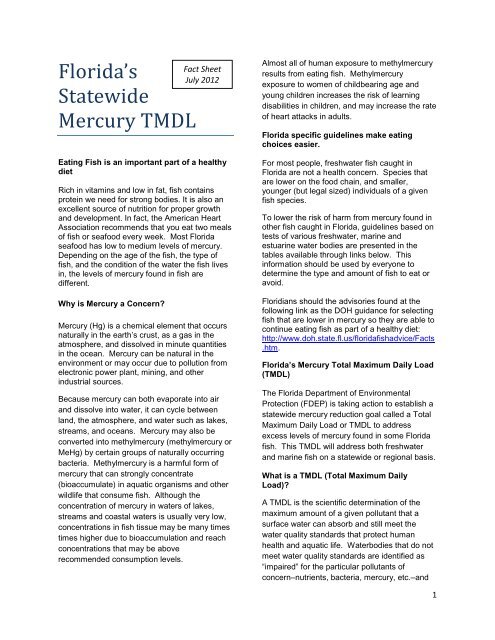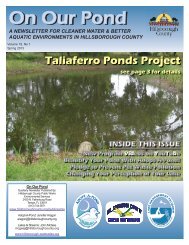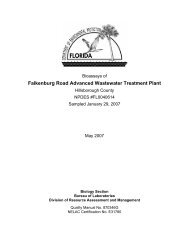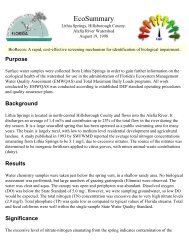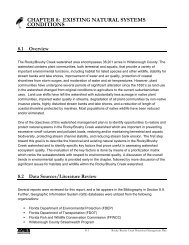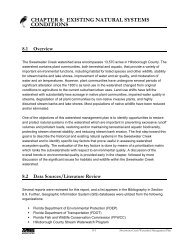Florida's Statewide Mercury TMDL Fact Sheet
Florida's Statewide Mercury TMDL Fact Sheet
Florida's Statewide Mercury TMDL Fact Sheet
You also want an ePaper? Increase the reach of your titles
YUMPU automatically turns print PDFs into web optimized ePapers that Google loves.
Florida’s<strong>Statewide</strong><strong>Mercury</strong> <strong>TMDL</strong>Eating Fish is an important part of a healthydietRich in vitamins and low in fat, fish containsprotein we need for strong bodies. It is also anexcellent source of nutrition for proper growthand development. In fact, the American HeartAssociation recommends that you eat two mealsof fish or seafood every week. Most Floridaseafood has low to medium levels of mercury.Depending on the age of the fish, the type offish, and the condition of the water the fish livesin, the levels of mercury found in fish aredifferent.Why is <strong>Mercury</strong> a Concern?<strong>Fact</strong> <strong>Sheet</strong>July 2012<strong>Mercury</strong> (Hg) is a chemical element that occursnaturally in the earth’s crust, as a gas in theatmosphere, and dissolved in minute quantitiesin the ocean. <strong>Mercury</strong> can be natural in theenvironment or may occur due to pollution fromelectronic power plant, mining, and otherindustrial sources.Because mercury can both evaporate into airand dissolve into water, it can cycle betweenland, the atmosphere, and water such as lakes,streams, and oceans. <strong>Mercury</strong> may also beconverted into methylmercury (methylmercury orMeHg) by certain groups of naturally occurringbacteria. Methylmercury is a harmful form ofmercury that can strongly concentrate(bioaccumulate) in aquatic organisms and otherwildlife that consume fish. Although theconcentration of mercury in waters of lakes,streams and coastal waters is usually very low,concentrations in fish tissue may be many timestimes higher due to bioaccumulation and reachconcentrations that may be aboverecommended consumption levels.Almost all of human exposure to methylmercuryresults from eating fish. Methylmercuryexposure to women of childbearing age andyoung children increases the risk of learningdisabilities in children, and may increase the rateof heart attacks in adults.Florida specific guidelines make eatingchoices easier.For most people, freshwater fish caught inFlorida are not a health concern. Species thatare lower on the food chain, and smaller,younger (but legal sized) individuals of a givenfish species.To lower the risk of harm from mercury found inother fish caught in Florida, guidelines based ontests of various freshwater, marine andestuarine water bodies are presented in thetables available through links below. Thisinformation should be used by everyone todetermine the type and amount of fish to eat oravoid.Floridians should the advisories found at thefollowing link as the DOH guidance for selectingfish that are lower in mercury so they are able tocontinue eating fish as part of a healthy diet:http://www.doh.state.fl.us/floridafishadvice/<strong>Fact</strong>s.htm.Florida’s <strong>Mercury</strong> Total Maximum Daily Load(<strong>TMDL</strong>)The Florida Department of EnvironmentalProtection (FDEP) is taking action to establish astatewide mercury reduction goal called a TotalMaximum Daily Load or <strong>TMDL</strong> to addressexcess levels of mercury found in some Floridafish. This <strong>TMDL</strong> will address both freshwaterand marine fish on a statewide or regional basis.What is a <strong>TMDL</strong> (Total Maximum DailyLoad)?A <strong>TMDL</strong> is the scientific determination of themaximum amount of a given pollutant that asurface water can absorb and still meet thewater quality standards that protect humanhealth and aquatic life. Waterbodies that do notmeet water quality standards are identified as“impaired” for the particular pollutants ofconcern–nutrients, bacteria, mercury, etc.–and1
<strong>TMDL</strong>s must be developed, adopted andimplemented for those pollutants in order toreduce pollutants and restore the water body sothat designated uses are attained.The threshold limits on pollutants in surfacewaters – Florida’s surface water qualitystandards – are set forth primarily in rules 62-302 and 62-303 of the Florida AdministrativeCode (FAC).How are Florida’s waters assessed?For assessment purposes, the FDEP hasdivided the State’s surface waters into over 6400assessment units, each with a unique waterbodyidentification number (WBID). FDEP assessesmercury impairments based on the FloridaDepartment of Health’s (DOH) fish consumptionadvisories. DOH issues advisoriesrecommending that individuals limit theirconsumption of certain fish from water bodieswhere mercury concentrations are elevated.Sources of <strong>Mercury</strong> to the StateAtmospheric deposition of mercury (from rainfalland the settling of dust) to waterbodies is thepredominant source of mercury in Florida. Whilea portion of the mercury present in theatmosphere is due to natural processes (e.g.,emissions from volcanoes), about two-thirds isfrom human activities which release mercury tothe air. The sources of mercury to Florida’swaterbodies originate globally and locally,coming from halfway around the world and fromlocal sources. Florida’s latitude, geographicalsetting and meteorology allow a high rate ofmercury deposition from the atmosphere ontoFlorida’s lands and waters.<strong>Mercury</strong> Impaired WatersCurrently in Florida, there are a total of 12,994square miles (freshwater and marine) and 2,903stream miles of waters that have been verifiedby the State as impaired for mercury.Number of WBIDs and Miles/Square MilesImpaired for <strong>Mercury</strong> (in Fish Tissue) byWaterbody TypeWaterbodyTypeNumber ofWBIDsImpairedMilesImpairedStreams/Rivers 265 2,903WaterbodyTypeNumber ofWBIDsImpairedSquareMilesImpairedLakes 128 1,344Estuaries 588 5,163Coastal 151 6,4872


